The world and national character ooze out! The Unsuspected World of “Test Writing” at Stationery Stores
Friday's Collecting Originals, Vol. 12 "What I found when I collected trial scribbles from all over the world
There is a planner named Hiroki Terai. You have probably seen at some point the somewhat unusual terms “divorce ceremony,” “tearful life,” and “bad stick. The man who invented and produces them is Mr. Terai, who will appear in this issue. He also has another unusual activity: a collection of “test pens” in the pen section of a stationery store. Mr. Terai, who has written a book titled “Trial Pens: The World Seen from Trial Pens” (Gomashobo Shinsha), which introduces the trial pens he has collected not only in Japan but also around the world, showed us the actual items in his collection.
It started not from Japan to the world, but from the world
───First of all, please tell us how you started your collection.
Terai: I was wandering around the world in 2007, about 15 years ago, when I happened to meet him in a stationery shop in Belgium.
─ ─ When I first learned of the existence of this collection, my first thought was that Mr. Terai, who was in Japan, had seen a test pen he was interested in at a stationery shop where he went to buy a pen, started collecting it, and eventually expanded his collection around the world. Then I realized that the order was reversed.
Terai: Yes, he started out in Belgium.
───That is, you suddenly started out wandering around the world. You have written about that in your book, but could you tell us again in your own words?
Terai: I quit my job after working for three years and set out on a journey to see the world as a kind of late “self-discovery” since I was 27 years old at the time. I left Japan, traveled around Europe, went to Africa, and then to Asia, and I thought I might come back when I ran out of money.
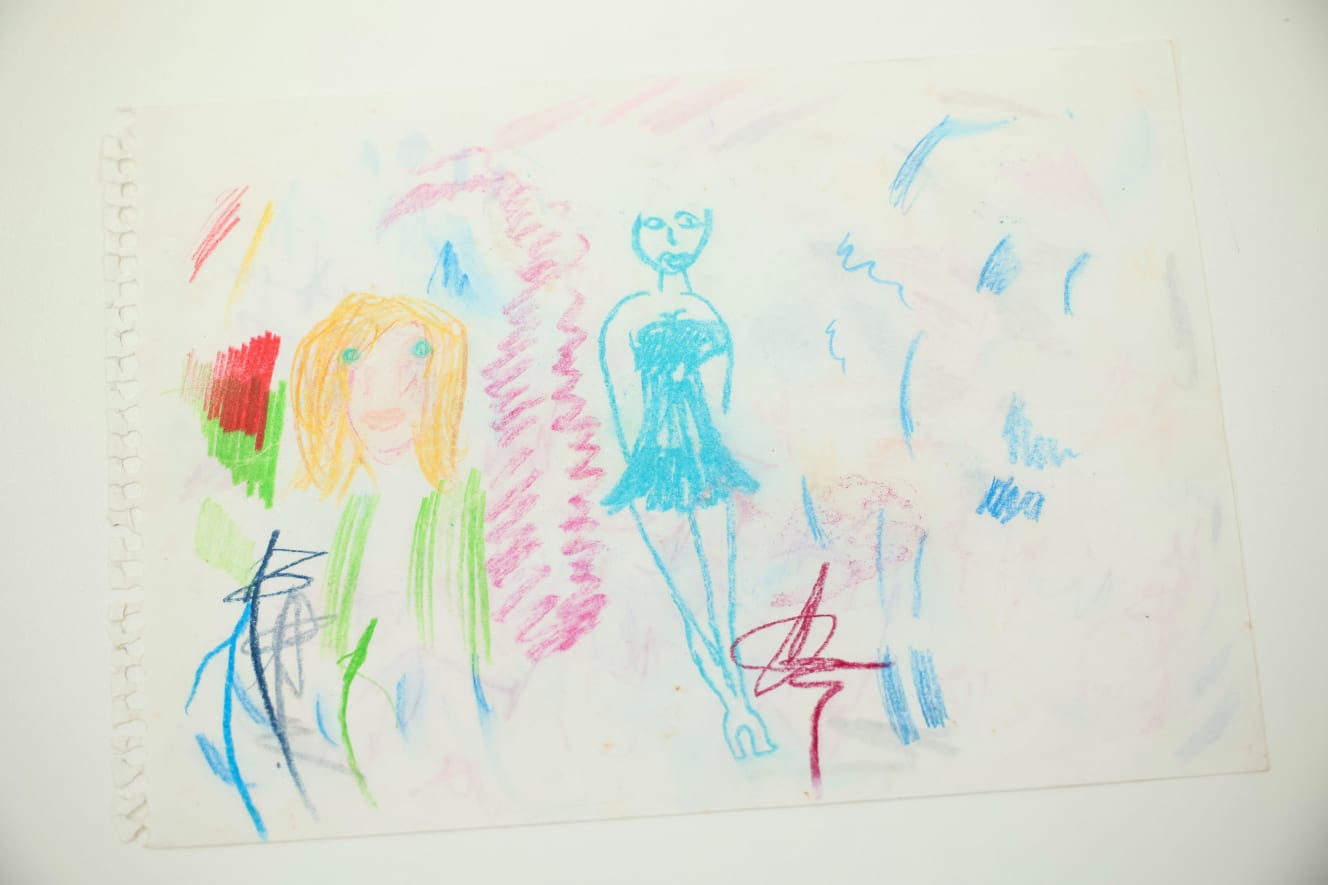
─ Did you have any plans to go to the U.S.?
Terai: I had been there before, so I did not think about the U.S. at that time. So, first I went to England, and then I visited Belgium, and that is where I met the trial drawing.
─ Ah, at a rather early stage.
Terai: And so it was in Belgium, and also in France, but the trial scribbles in Europe were more artistic or colorful. At that time, I wondered, “Come to think of it, what were Japanese trial scribbles like? I wanted to go back to Japan right away.
I wanted to go back to Japan right away. (laughs) So it was such a big encounter. But you didn’t suddenly return to Japan, did you?
Terai: Of course, I continued traveling after that. I met many people on my travels, and when I showed them what I had collected, their reaction was always the same: “Why are you collecting all this garbage? I was very happy to hear that. That makes me very happy.
Terai: Not frustrated, but happy?
Terai: In other words, I was convinced that only I could understand the appeal of the trial scribbles, and that this was worth collecting.
─ I see. It would be boring if everyone knew the appeal and everyone collected them, wouldn’t it?
Terai: Then, when I came back to Japan and showed them to the people around me, they said, “This is so interesting! I was really excited. What I thought was my own personal treasure suddenly seemed like trash.
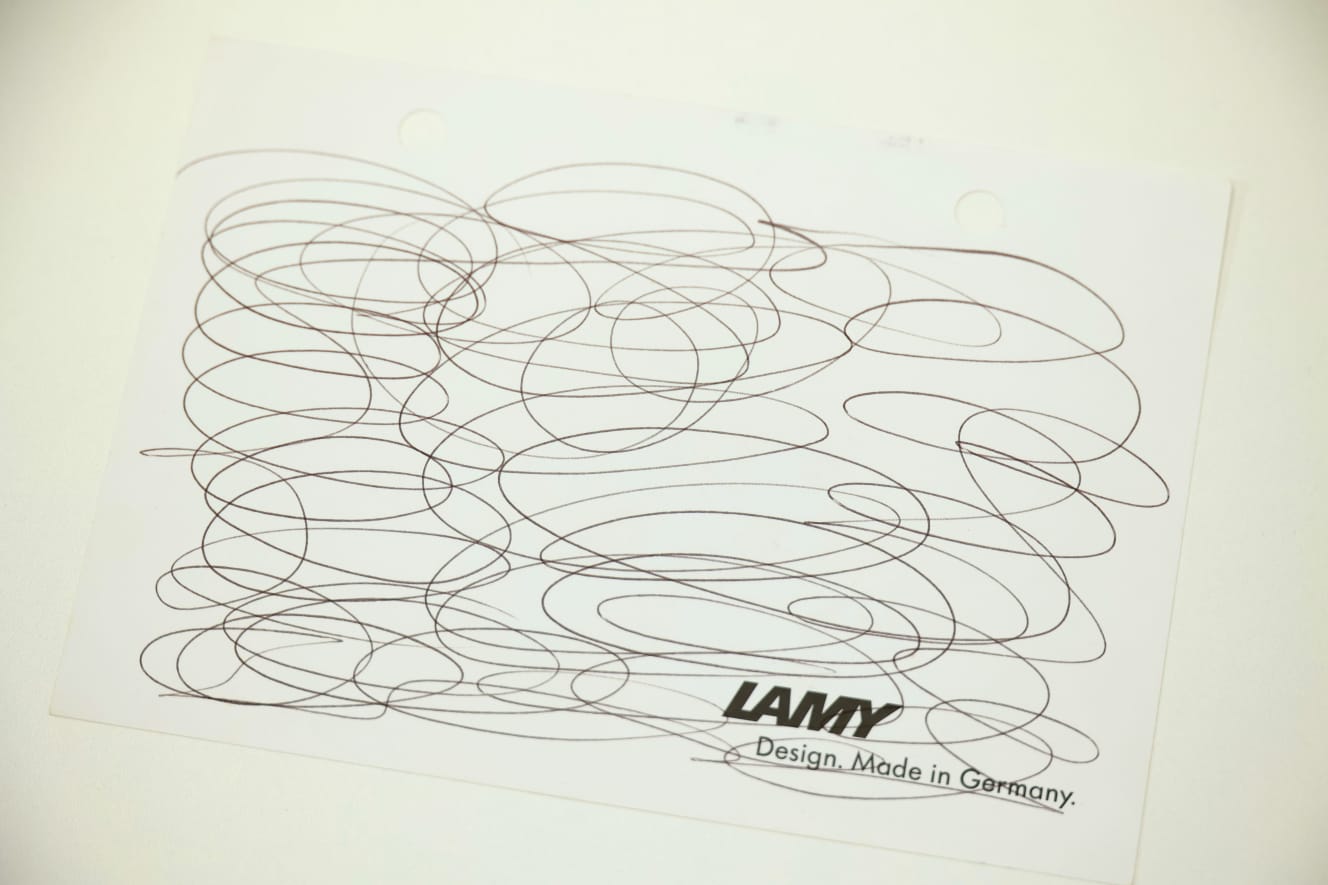
─ ─ That is a complicated collector’s mind, isn’t it? But, well, like me, there are many people who find trial scribbles interesting, and since you have collected trial scribbles from all over the world, you must have become the talk of the town right away, didn’t you?
Terai: No, I didn’t want to be interviewed by the media for a while, so I refused to do any interviews about the test scribbles.
─ Is that because …… might imitate you?
Terai That was one reason, but I also subconsciously feared that people would stop writing about it.
─ ─ Well, once you know that there are people who pay attention to test-writing, when you go to a stationery store to test-write, you have some kind of awareness of what you are doing. You might try to write strange words on purpose.
Terai That’s right. I didn’t want to do that. Well, as it turned out, my fears were unfounded. Anyway, I did not receive any interviews for a few years, but I received a request for an interview from a writer, and when I showed it to him, he talked about it in a unique way, and from there I began to receive interviews.
─ After that, you were actively involved in exhibitions, weren’t you?
Terai: Yes, and since then I have been actively sending out information myself.
The memorable first piece you acquired in Belgium
─ ─ Let me back up a little. I heard that you met your first piece in a town called Aalst, Belgium.
Terai: It’s a peaceful country town, not a tourist destination, so it’s not the kind of place that most travelers would go. But in my case, it was a trip with no destination. Stationery stores there have a different image from those in Japan: they are like IKEA-like furniture stores or bookstores with a stationery section in the corner.
─ ─ It is not a specialty stationery store, but rather a stationery corner.
Terai: I found this Belgian test copy in such a place, along with several other sheets of the same kind of paper. I wanted to have this test copy so badly, so I asked the shopkeeper about it.
─ ─ If the paper was long and thin and small like Japanese paper, I would not be afraid to take it without permission, but with this size (about A4), it would be awkward to peel it off and take it without permission.
Terai: So when I took this whole stack of paper to the store clerk and asked for it, he must have thought I wanted new paper. He ripped off the top sheet and told me to take a blank sheet. I said, “NO, NO, this way!” After some back and forth, I finally got it.
─ ─ So this is the first one to be commemorated.
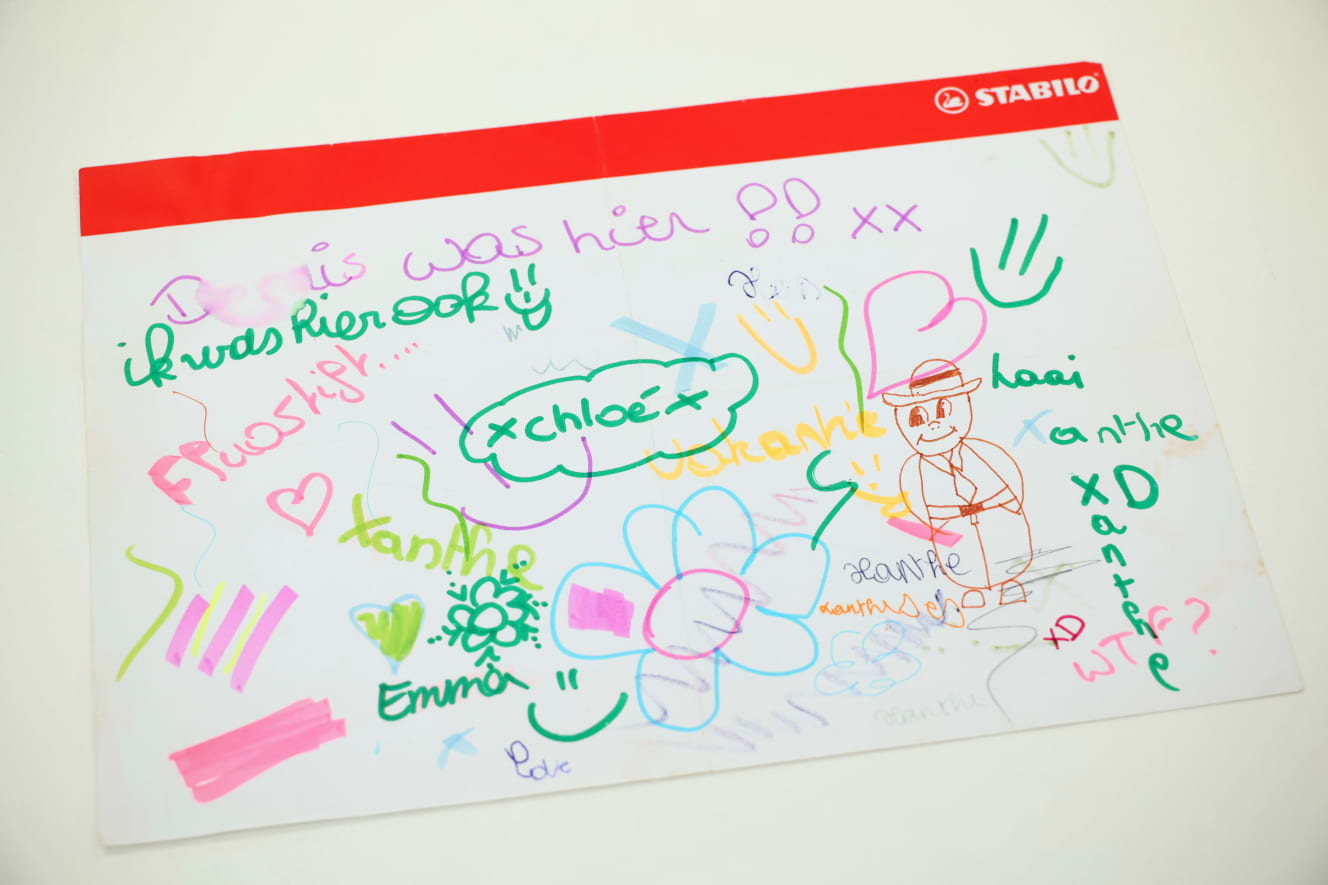
Terai: The use of various color pens is beautiful, and this drawing on the right is probably a popular local character. The drawing on the right is probably a popular local character.
─ ─ Yes, these are trash to the locals, but if you see them on a trip to a foreign country, you will want to have them.
The direction of interest that came to me as I continued to collect
─ ─ It is not that you originally liked stationery or anything like that, but you just happened to come across them during your travels and started collecting them, didn’t you? I guess it’s a good thing that this was the first one. If they had been smaller or more plain in size, they would not have caught my eye. In fact, when I was in Japan, I overlooked them.
Terai: Yes, that may be true. What is it? I thought this was “unconscious art.
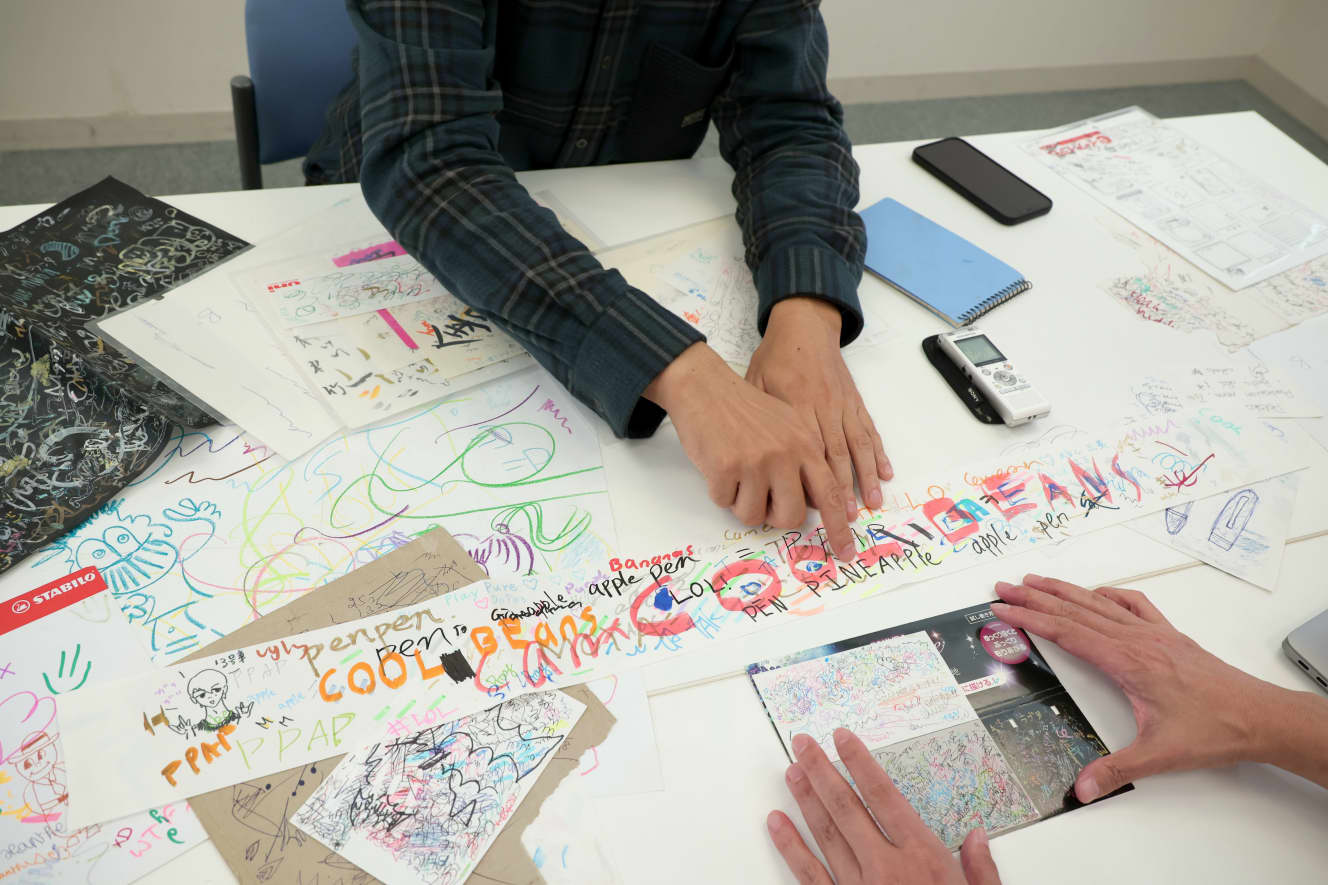
─ ─ I myself have been aware of these trial scribbles for a long time, and whenever I saw them at stationery stores, they always stuck in the corner of my mind. But it never occurred to me to collect them. I knew there had to be a strong trigger. In your case, I imagine that your encounter with these “artistic” test scribbles in a foreign country called “Belgium” was a big trigger for you.
Terai That’s really true. From then on, whenever I found a stationery shop, I would stop by. But my tastes change.
─ What do you mean by “tastes”?
Terai: Well, 15 years ago, when I first started collecting, I would collect every single piece of stationery I could find, saying “I’ll take this and go home,” but now I’ve become extravagant.
But now it has become a luxury.
Terai: I don’t touch anything anymore unless it is something that really moves me. I think it is the same with any collection, but even if you start out collecting randomly, you will eventually find a direction of interest.
─ I understand. You find a new perspective, don’t you?
Terai: So there are many things that I acquired about 15 years ago that, when I take them out now, I wonder why I brought them home with me. My tastes have changed over the past 15 years, and I am sure that 15 years from now, people will have different tastes than they do now.
Each country’s character is reflected in the trial writings.
─ ─ After starting in Belgium, to which country did you go next?
Terai: We went to France, Spain, Germany, and Italy, in that order.
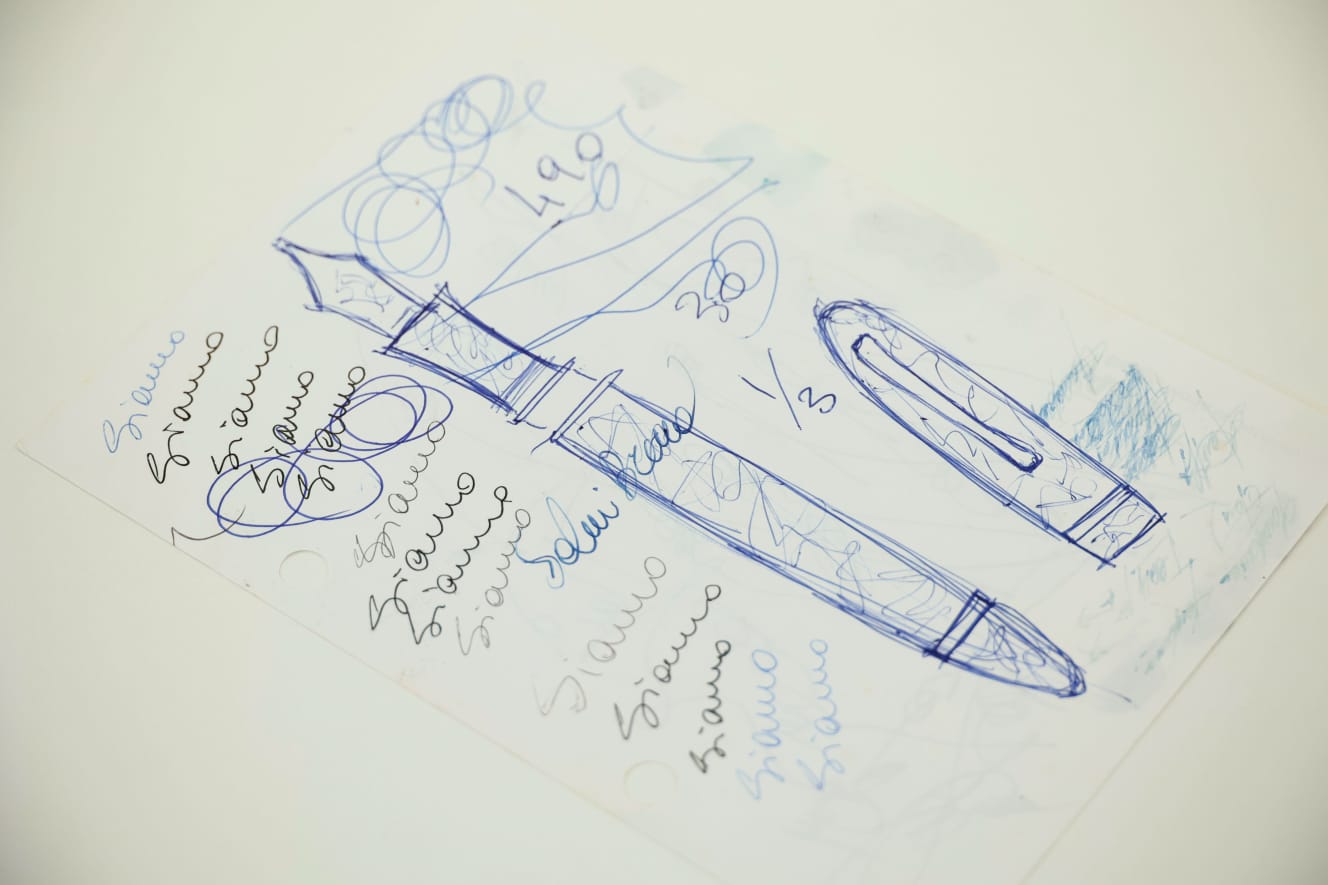
─ This is the one you later framed at an exhibition and were asked to sell it for 200,000 yen!
Terai: At the time, I reflexively refused, but now I wish I had sold it.
─ That’s right, if I had 200,000 yen, I could go to Italy one more time (laughs).
Terai: Well, anyway, Europe is expensive in many ways, so I couldn’t stay there for very long. I was running out of money, so I decided to move on to Africa, where I could travel inexpensively.
───Which parts of Africa did you visit?
Terai: Ethiopia, Kenya, Tunisia, and South Africa. …… This is Ethiopia.
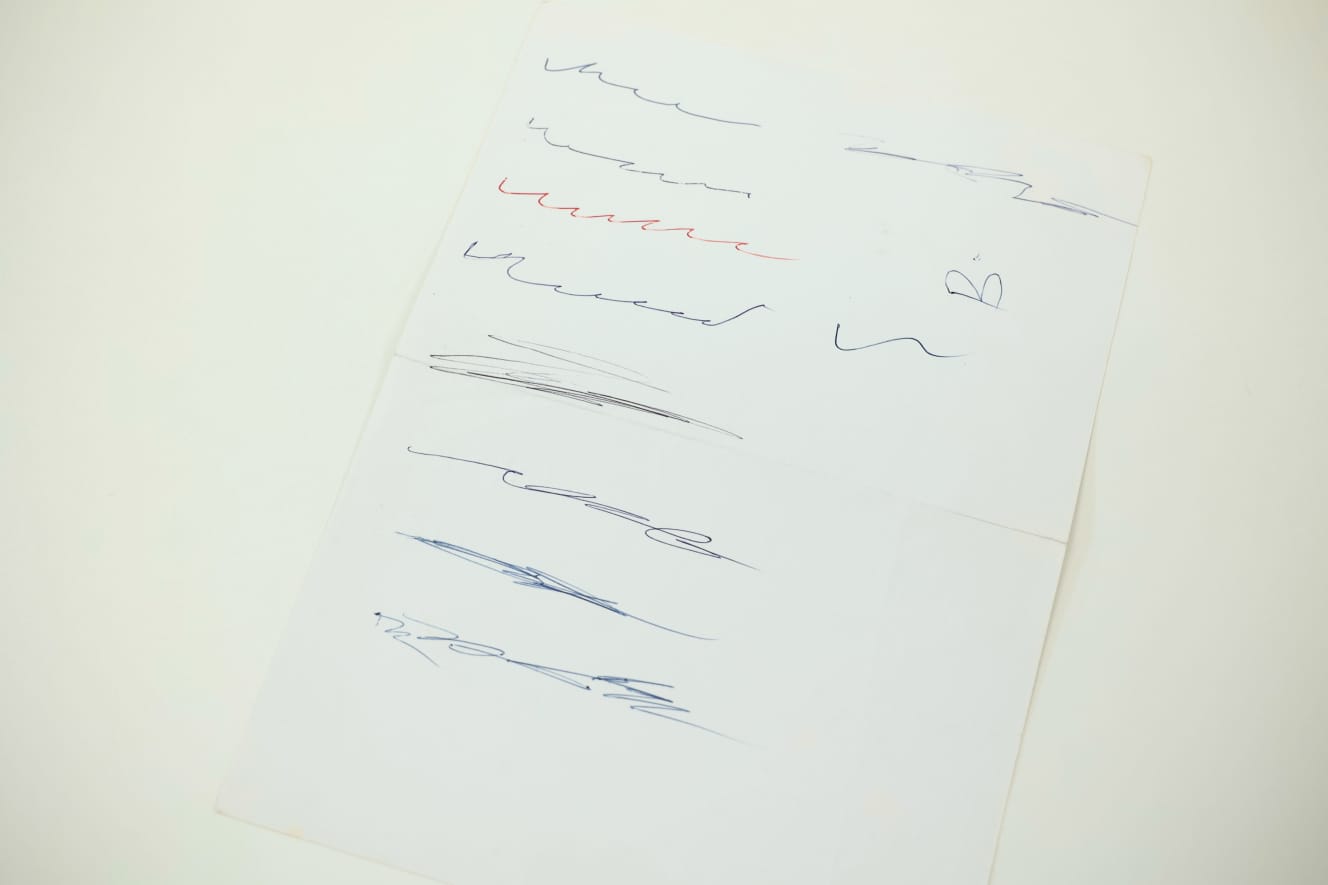
Terai: But this is a very symbolic trial stroke, and it is characterized by high writing pressure. The quality of stationery over there is not so good, so they really try to see if they can write.
I see, you are testing whether you can write in the first place before testing writing comfort!
Terai: This is from Kenya, but the writing pressure is so high that the paper is torn.

Terai: It is normal for Japanese pens to produce ink, but over there, at least one out of three pens may not be able to write. So I seriously try them out, so I don’t have time to draw illustrations. The French ones seem to have a lot of leeway, don’t they?
The pleasure of imagining the meaning of the words left on the trial scribbles
─ ─ So you traveled around Africa, and from there to Asia.
Terai: India, China, Korea, and so on. Even in Asia, each country has its own characteristics. This one is from India, which is indeed a country of mathematics.
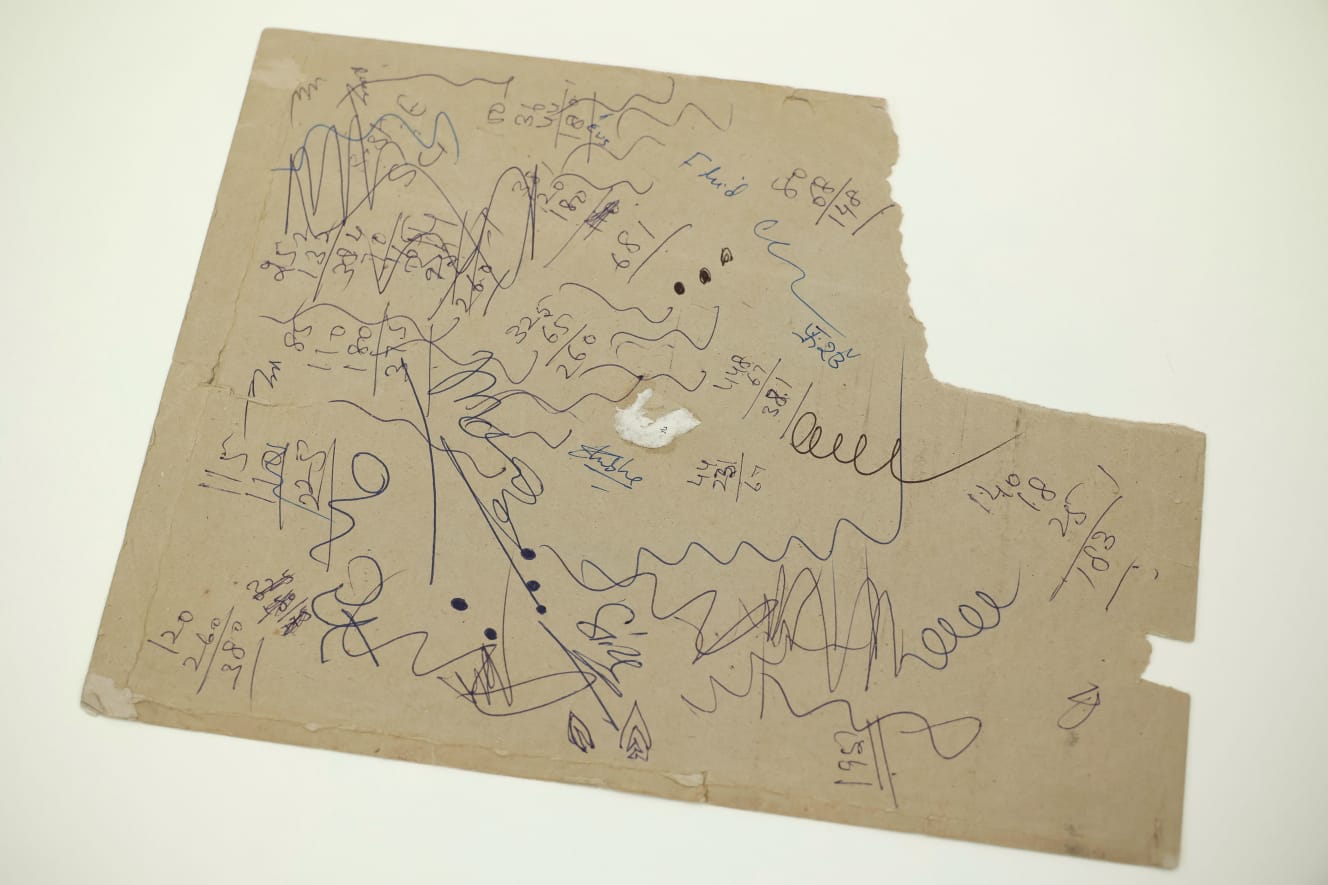
This one is addition, this one is subtraction. What is the black circle?
Terai: I don’t know, but maybe they practiced filling in the mark sheets.
I hope that’s the reason.
Terai And this one is from China.
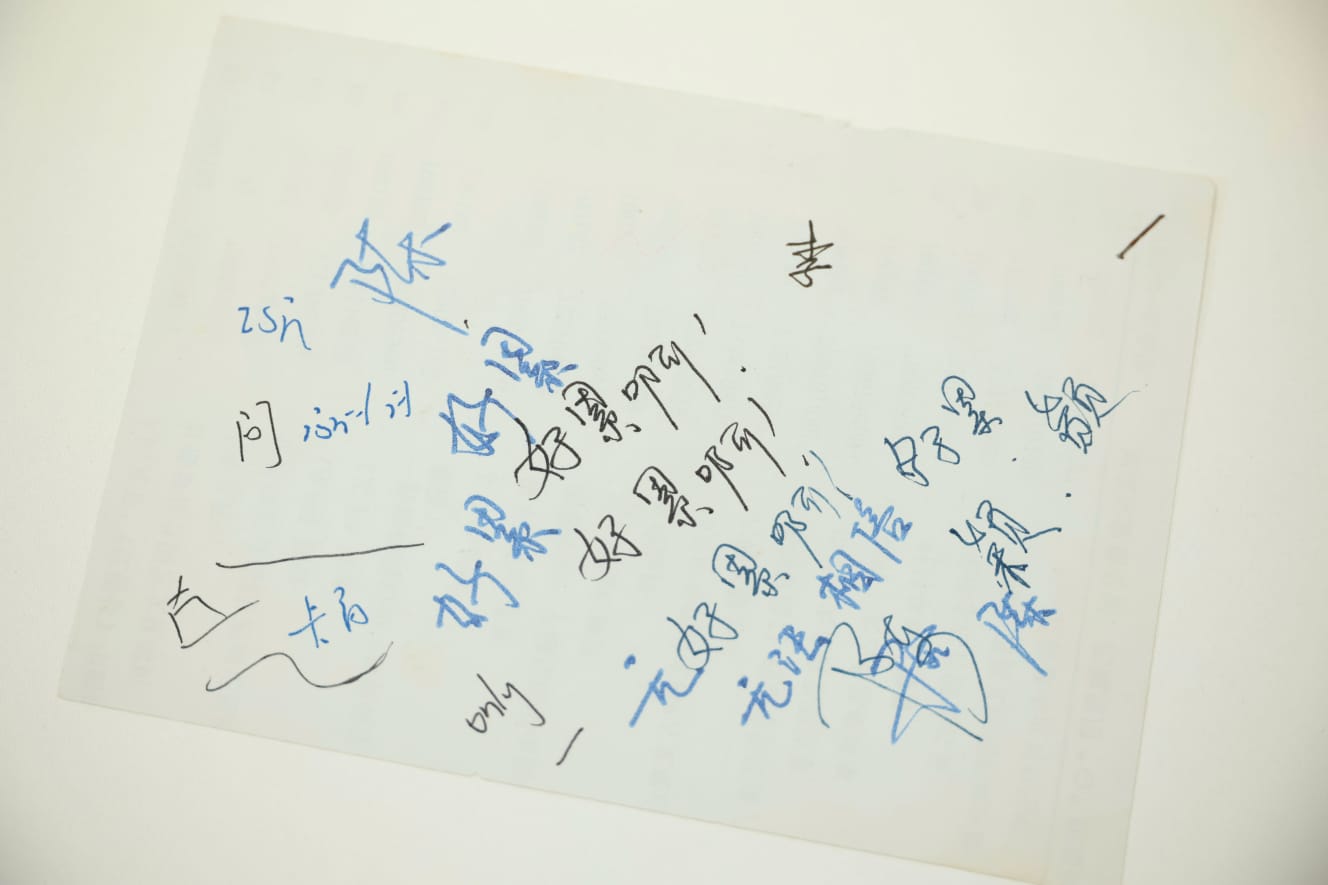
Terai: China is a nation of complainers, isn’t it? There are a number of “好累~” written in Chinese characters, which means “I’m tired! I am tired! It means “I’m tired!
Terai: I see.
Terai: Below that, there is a slightly unreadable character “yuan” for “yuan” and “xiangxin,” which, according to a Chinese person, means “I can’t trust.
─ ─ Indeed, there are a lot of complaints written on it! (laughter)
Terai: It must have been something serious. (Laughs.) Terai: They must have been really upset. My interpretation is that instead of social networking sites, they are using test writing as an outlet for their dissatisfaction.
I like that. It is more fun to imagine in this way than to know what the correct answer is.
The year’s most popular words can be seen from the trial writings.
─ In your book, you say that you have collected about 20,000 trial scribbles from 106 countries.
Terai: No, I have actually been to only about 20 countries. After I started publishing my collection, various people started sending me things from various countries, and now I have a total of 108 countries.
─ Ah, I see. Then, since you have continued to collect and send items yourself, the number has increased even more, hasn’t it?
Terai: I have about 45,000 items now.
───That’s an increase!
Terai: These are mainly Japanese testimonials, or “vogue words,” as you call them.
───Yes, I really liked what you wrote in your book about “the year’s most popular words can be seen from the trial scribbles.
Terai: For example, this one is “STAP cells exist! and another person responded to it by saying, “Hey! and another person made a tskkomi (a comment) in response to it.

And then, “SMAP is the best! rhymes with “SMAP is the best!
Terai: In this way, the test scribbles sometimes reflect the trends of the time. For example, when I got the “PPAP” I mentioned earlier, I didn’t know Piko Taro, so I only saw “PEN” and “APPLE” as words. Later I found out that it was a record of that era.
─ ─ I guess one-shot gags by comedians tend to be written.
Terai: Some of the earlier ones were “rassungorerai,” “jee-jee-jee,” “double payback! and “Double payback! There were a lot of “double payback.
─ ─ Naoki Hanzawa must have had a great influence on the test drawing.
Terai: Also, the number of “Reiwa” has increased with the change of the era, and “Amabie” is a rather recent one.
─ ─ The influence of the COVID-19 crisis has also reached the world of testimonials!

Terai: There are also “Social Distance” and the hashtag “Let’s #Dance at Home”.
─ ─ It’s a song by Minamoto Hoshino. I guess the era of Corona is reflected in the test copy as well.
A test piece of writing from the polar regions. And someday, it will go to space.
─ Mr. Terai has been holding an exhibition titled “World Tameshigaki Exposition” of the many test scribbles he has collected, starting with Tokyo in 2012, followed by Osaka, Kobe, Sapporo, Okinawa, and from 2013, overseas locations such as Belgium and Bhutan. Where does this vitality come from? Is it the fact that there are people who cooperate with us?
Terai: Yes, thankfully there are many people who find this activity interesting, and it is thanks to them that we have been able to collect test pieces from such a wide range of countries, as well as the exhibitions. This one is from the North Pole.
The North Pole?
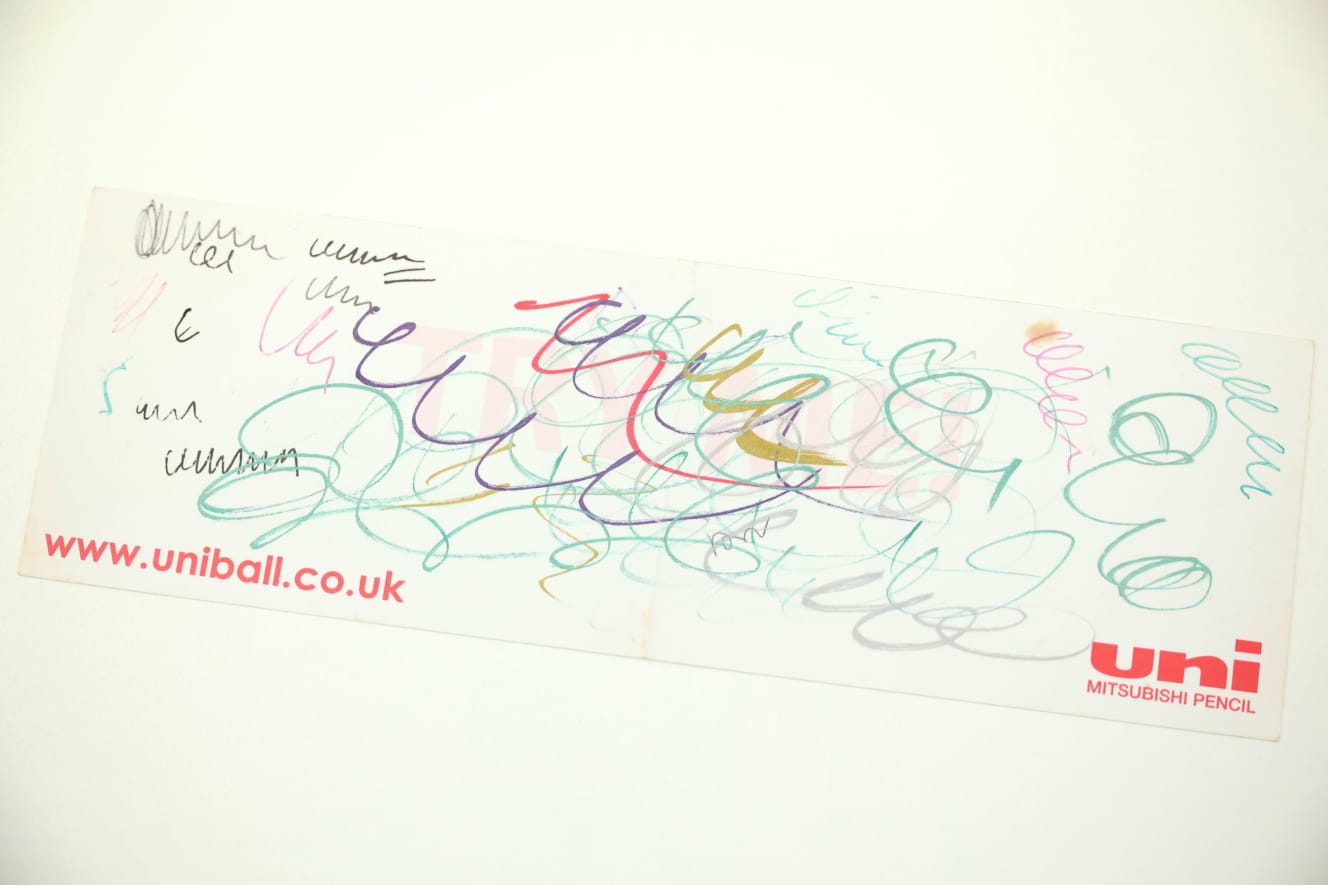
Terai: This person is a Japanese who lives in the North Pole, and he found this at the only store in town that sells household goods. He also sent us a photo of the area. When I looked at it, I saw a small bundle of paper popped up in a place where pens were lined up.
─ ─ It is wonderful to see how the connections are expanding like this from the exhibitions we have held around the country. If you had collected only Japanese test papers, the conversation would not have expanded to this extent.
Terai You are right. It would have been impossible to understand how the cultural differences among the countries of the world are reflected in the trial scribbles without collecting them.
─ Mr. Terai, you said that you didn’t want to be imitated by the mass media, but since we started with Belgium and have now covered the Arctic, no one will be able to catch up with us. If there is anything that can beat this, it would have to be a test pen that was thrown away by the Antarctic wintering party and found under the ice, or a test pen that was written by an astronaut working on the space station because his pen ran out of ink due to atmospheric pressure.
Terai: More to the point, I would like to see a trial drawing of an alien. I would like to go to Mars, for example, just to try out the pen.
─ ─ With your energy, Mr. Terai, I don’t think this is a joke.
The chaos of test writing, with simmered sea bream and ale flying about
Terai: Look at this. It is interesting to see “simmered sea bream” written with a brush pen.
The ink strokes are very vivid.
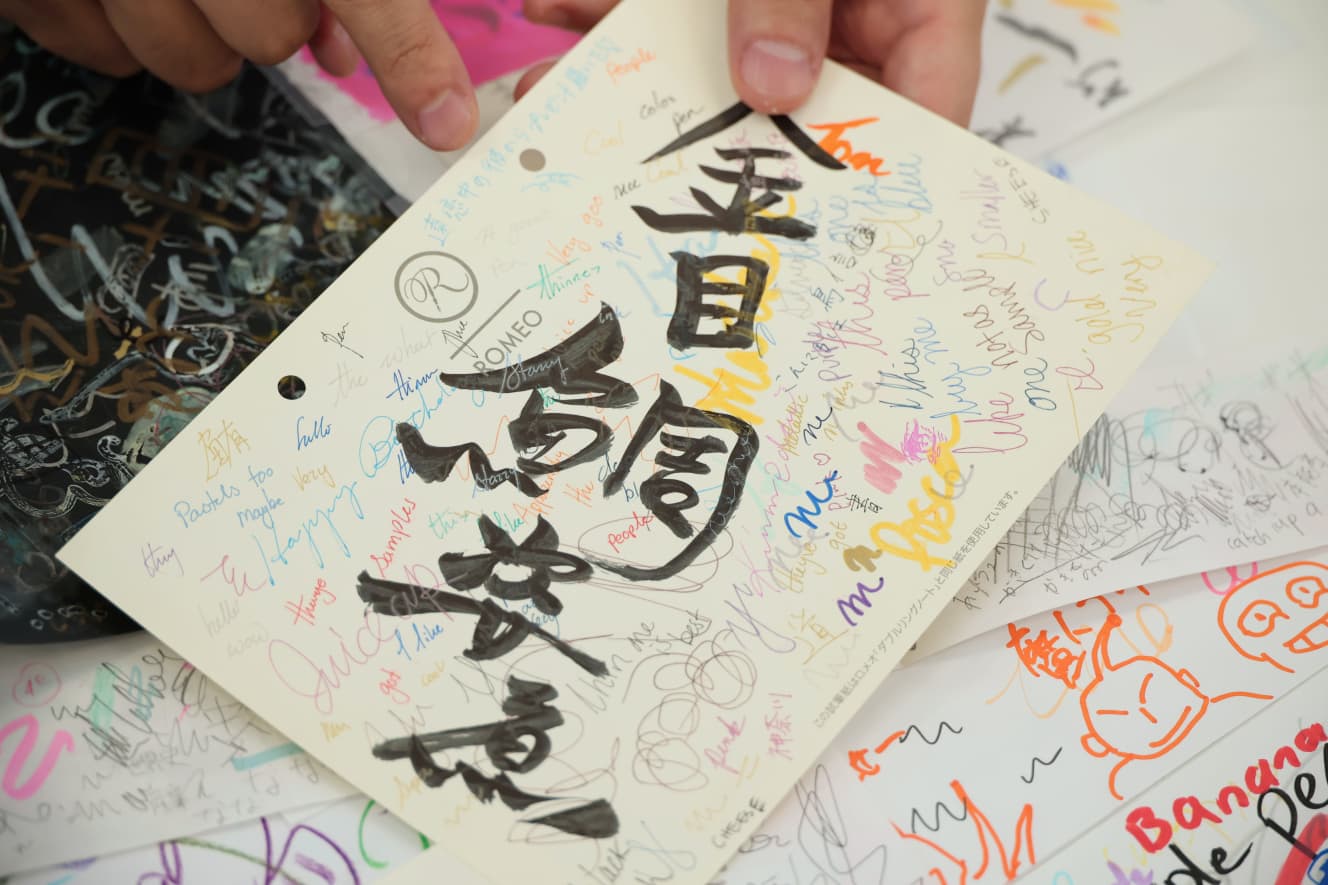
Terai: I tend to pay attention to the “kinmoku-tai-tai-gatani,” but if you look closely at the hole where the paper is bound, there is a small inscription in blue pen that reads, “A present arrived from a distant love, he who is in love with me.
─ ─ By “long-distance love,” you mean a long-distance relationship, right?
Terai: The interesting thing about the test handwriting is that when the girl secretly writes about her small joys, the old man, probably the one who did it, interrupts her without hesitation with a goldfish.
─ Perhaps the owner of the izakaya (Japanese style bar) practiced writing the menu with a brush pen.
Terai: I think this kind of thing also happens on SNS. It’s like an old man who can’t read the air interrupting a young person’s conversation. Another example is a message written in black pen, “I’m really tired of job hunting…,” with a blue pen beneath it saying, “Hang in there! The goal is getting closer! written in black pen, and underneath it in blue pen, “Hang in there!
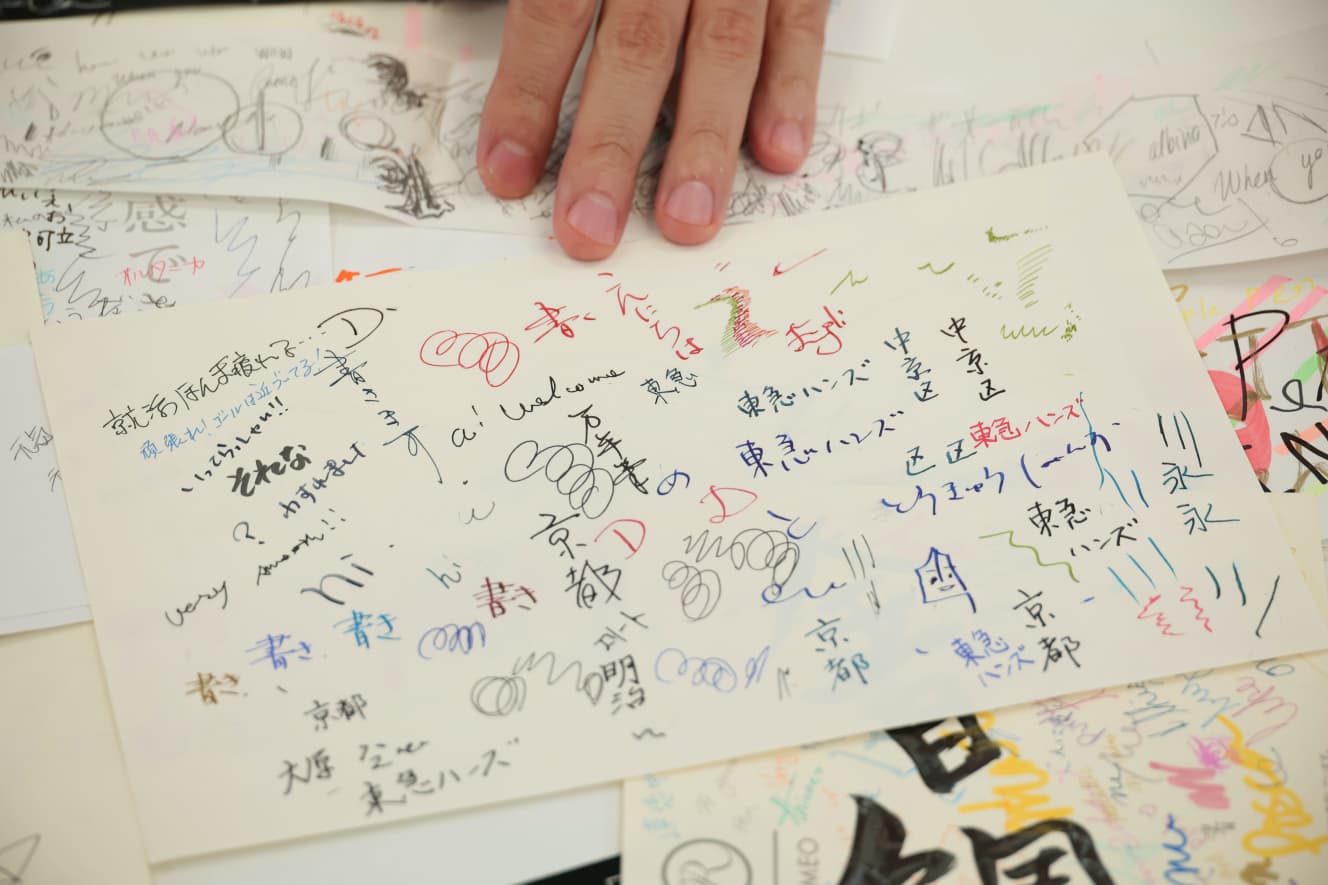
TeraiI thought it was kind at first, too, but when I looked closer, I realized that the handwriting was the same.
─ ─ Ha-ha-ha. But you know what I mean. The feeling of wanting to console yourself by writing a complaint.
Celebrity Names Often Written in Trial Writing
Ei – As you wrote in your book, the character for “Ei” contains all the tome, hane, and harai, so it is often written on trial scribbles. In the “Job hunting is really tiring…” paper I mentioned earlier, there was also an “Ei” on the far right side.
Terai: Yes, it is called “Eiji hachibo,” and the character for “Ei” contains eight different techniques necessary for calligraphy.
───But it was also interesting to hear that the characters in Rokusuke Ei’s signature have no “hane” or “harai.
Terai: Come to think of it, there are so many people who write the names of celebrities in their test scripts. This is Ayame Goriki.
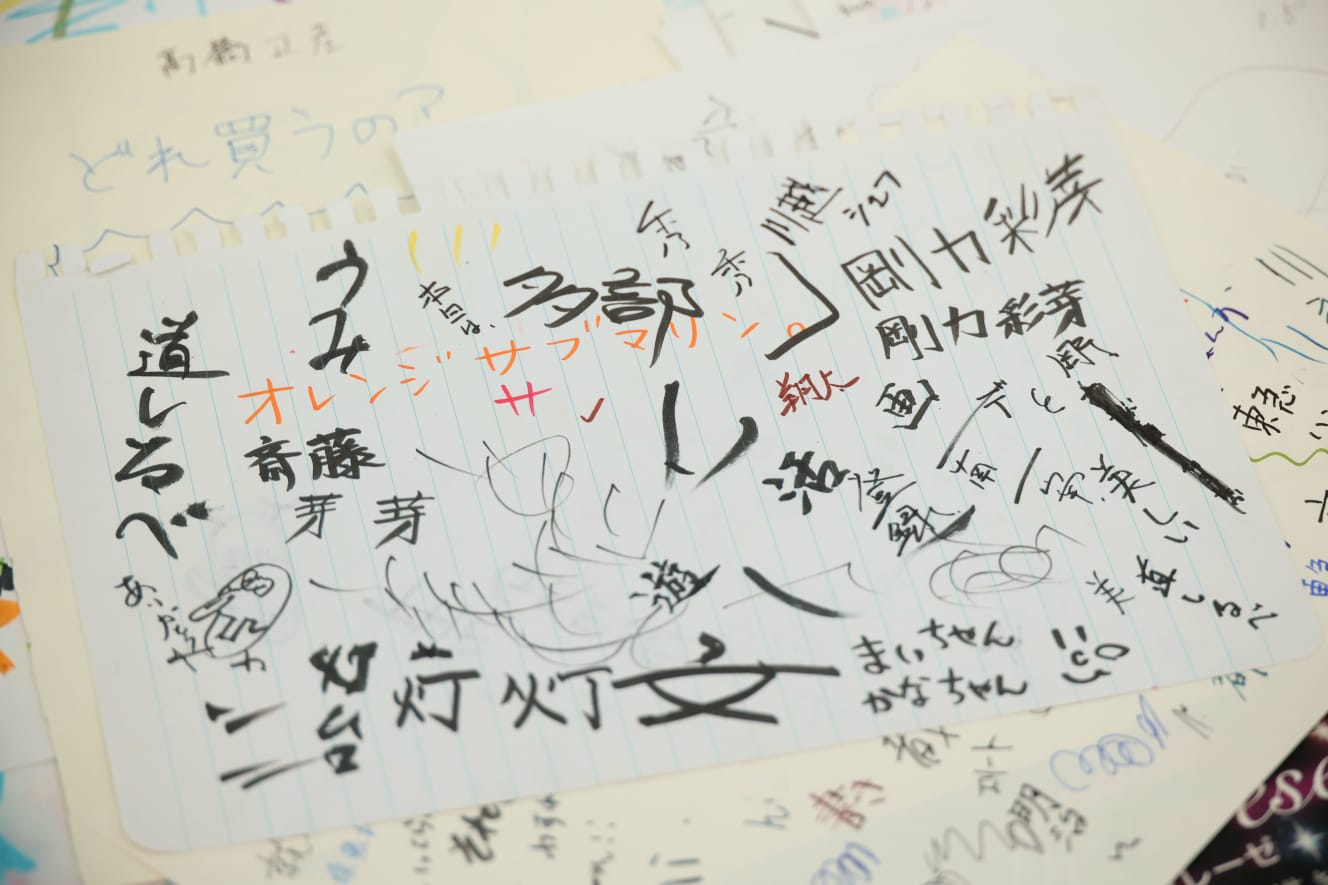
─ ─ I am sure that the “Tabe” next to it was intended to be written as “Mikako Tabe.
Terai: And “Kawagoe Chef” for some reason (laughs). Also, when SMAP was breaking up, I found a test piece with the names of all the members written on it.
I found a test drawing when SMAP was breaking up, and it had the names of all the members written on it. It must have been very difficult for a non-fan to write that.
Terai: And “Great Gidayu”. His name is also written in a surprisingly large number. It seems to contain “tome”, “hane”, and “harai”.
Hahahaha. I like the choice of “Gidayu” among the Takeshigunjin.
Terai: The top three celebrity names that are tried out are Rokusuke Naga, Ayame Goriki, and Danmitsu. There are a lot of Danmitsu-san’s as well.
─ I wonder if the more strokes a name has, the more people want to try writing it.
TeraiWhen I meet celebrities and other famous people for work, I ask them to try out my handwriting instead of signing it, but the one that Tetsuya Chiba gave me was, well, a signature.
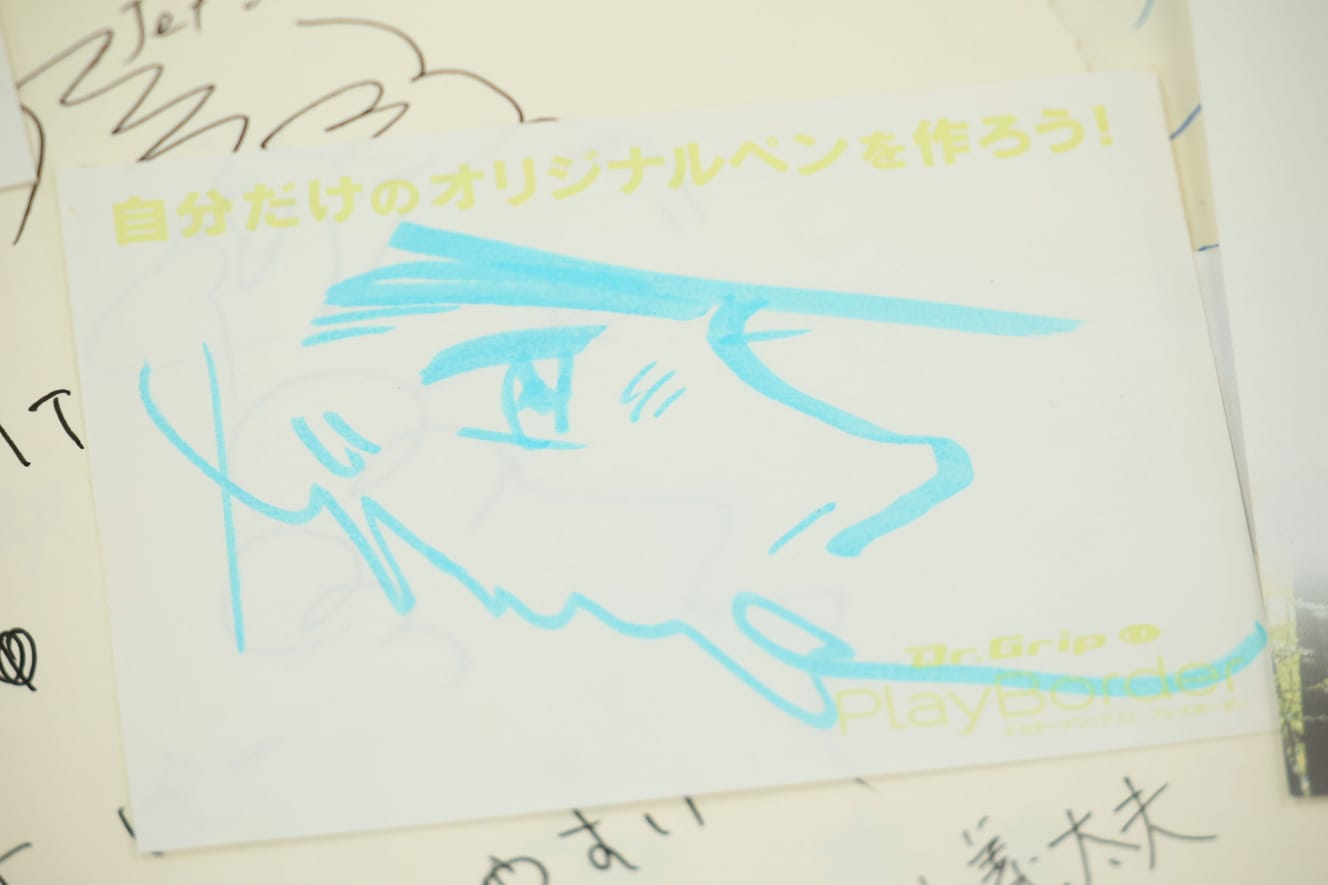
─ ─ No, this is wonderful. In Mr. Terai’s opinion, “autographs” are lower than “trial scribbles” for celebrities, but this one must be in a different class. And the fact that I’m seeing this in the Kodansha conference room right now makes it all the more wonderful!
What is the surprising similarity between “Trial Writing” and insect collecting?
─ This collection itself is still going on, isn’t it?
Terai: Yes, I stopped by Sekaido before coming here today and picked one up.
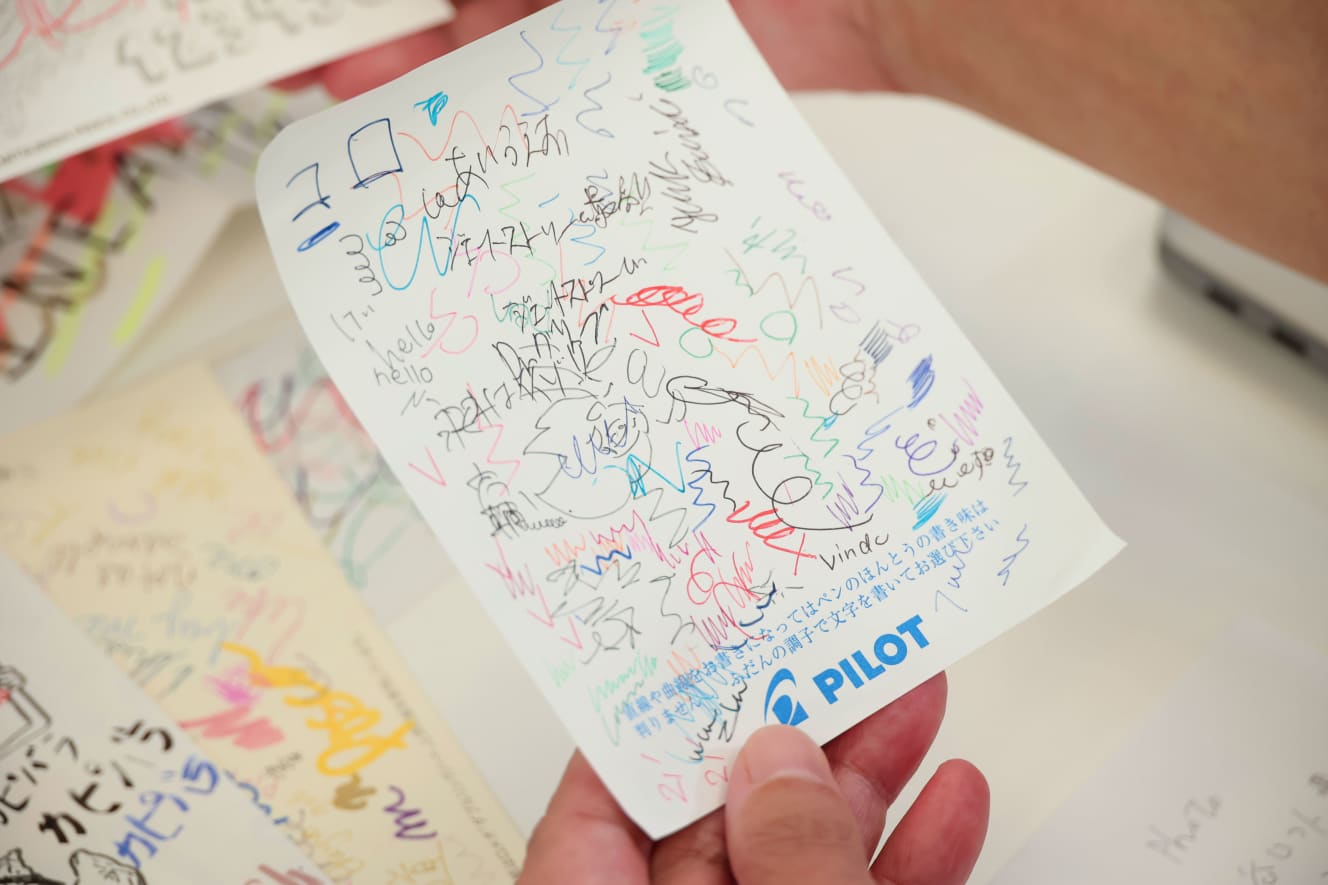
Terai: These days, by my own standards, I don’t take things like this home with me. But since I am being interviewed today, I took it.
─ I see, looking at this again after hearing what you have to say so far, it doesn’t say anything interesting, and if you don’t draw a line somewhere, there is no end to it, isn’t there?
Terai: Come to think of it, I felt a sense of distance in the letters that were written on the test sheets after the COVID-19 crisis began.
─ ─ Social distance!
Terai: But recently, the letters have become densely packed, as in these trial scribbles. It may be that people are becoming more conscious of wanting to “connect,” or it may simply be that the number of customers is increasing, but I can read something like that.
─ ─ Well, it is interesting to see that although these seem to be ordinary trial scribbles, by knowing when they were written, changes in social conditions come to the surface. Another thing that Mr. Terai pointed out in his book is that the test scribbles are in the process of growing up and being written freely, as long as they are left on the store shelves. He said that he felt a sense of caution about taking them away and interrupting their growth. He expressed this as “not destroying the ecosystem of trial writings.
Terai: Oh, I wrote something like that.
─ ─ I think that this is connected to what you said at the beginning, that if we publicize the fact that we collect test sheets, then when people go to stationery stores to test sheets, some kind of intention may be mixed in. It would be an alteration of the very ecosystem.
Terai: You are absolutely right. However, there is also the possibility of leaving the books in the store in the hope that they will grow more, only to find that they have already been discarded when you return to pick them up after some time has passed. It is a difficult conflict.
─ ─ When you think about it that way, it could be said that all of the test scribbles you brought today were born through miraculous encounters and timing.
Terai: Yes, the test samples are living creatures, so no two are the same, and they stop growing when I obtain them.
Terai: So it is similar to collecting insects. For example, when I find a big stag beetle, I say to myself, “I found a big one! and I catch it, it stops growing there. If you leave it alone, it may grow even bigger. But it might fly away. It might be preyed upon by another creature.
Terai: That’s true. Trial drawing is like collecting insects.
Mr. Terai’s Producing Business Develops from a Unique Perspective
─ ─ I have heard everything I wanted to know about your test writing. Could you tell us a little more about your other activities? Mr. Terai is also known as a producer of “divorce ceremonies. I assume it is a divorce ceremony as opposed to a wedding ceremony, but what exactly does it entail?
Terai: Basically, the couple who are separating vow to each other to make a fresh start in front of their friends and acquaintances. They dare to announce it in front of everyone and leave the aftermath behind (laughs). Also, we do things like smashing rings with a hammer. It looks sensational at first glance, but inside, everyone is serious and it is a ceremony to look forward.
Official website of the divorce ceremony
─ ─ And then there is “Nijikatsu (tearful activity). It is a mental detoxification process that involves consciously shedding tears and stress.
Terai: We have an unspecified number of people gather together, and we have a crying storyteller called Crying Stone House Reiteration …….
─ ─ Wait a minute, did you just say “rakugo ka”?
Terai It is a rakugo ka, a storyteller who tells a story that makes you cry. There is a Rakugo storyteller named Nakashiya Reisho on the Tearjerker staff. He performs human-interest stories that make people cry, and our tear sommelier selects video works that make people cry. I have been doing this activity for about nine years now, and I have made about 20,000 people cry so far.
Official website of Tearful Activity
───And one more thing, “Bad Stick”. Did you conceive of this, or rather produce it?
Terai: Yes, we came up with the idea of creating a product that would create a buzz when we heard that Choshi Dentetsu’s business situation was not good.
─ ─ Choshi Dentetsu has been doing various things to restore its business, such as making wet rice crackers and collaborating with “Momotaro Dentetsu”. I understand that the “Bad Stick” is part of that effort.
Terai: I had known the president for some time, so I asked him if he would be interested in making a “bad stick. and it was approved.
The official website of “Bad Stick
─ I am amazed that your plan was accepted. You must be a company with a sense of humor. And the image character is Mr. Hinohide Hinohideshi (laughs).
Terai: The “bad stick” is still selling well, selling about 4 million units over the past 4 years.
─ ─ Your point of view on the test piece was, of course, very interesting, and Mr. Terai’s ideas were all from unexpected perspectives!
(After the interview)
I first met Mr. Terai in 2012, so he must have already had a fairly substantial collection of test sheets by then. If anything, he may have even told me about his testimonials, but 10 years have passed without me digging deeper into them. The fact that we were able to have this opportunity, “Friday’s Collecting Genjin,” finally allowed us to see the whole picture. As a planner myself, I came up with the idea of the “Nazca jacket,” a new type of ska-jan that I commercialized based on the Nazca Lines, and just as I was a planner myself, Mr. Terai keeps coming up with new ideas and commercializing them or making them into events. I felt a great deal of sympathy for Mr. Terai.
Interview and writing: Akihito Tomisawa
A self-proclaimed professional collector who continues to study the ecology of people obsessed with collecting. He is the author of "Bottomless! The World of Big League Cards" (Sairyusha), "Hitokui Eiga Matsuri" (Tatsumi Shuppan), "MUGEN no Hondana" (Chikuma Shobo), "Record Koshi no Sengo Shi" (P-VINE), and other books all related to collecting. His latest book is "Yusha to Tank to Monster 1978~2018☆My 40 Year History of Video Games" (Komakusa Shuppan), which looks back on his own relationship with video games.
Photography: Katsumi Murata
